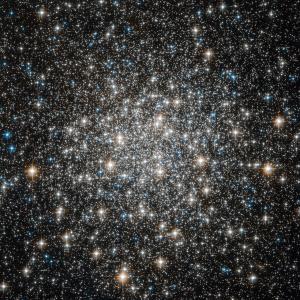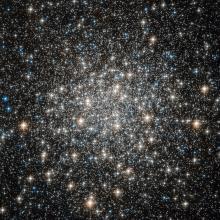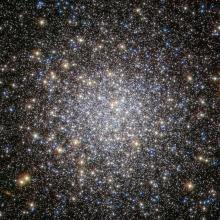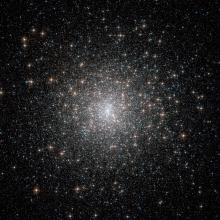Thousands of stars sparkle in this Hubble Space Telescope image of the core of Messier 10, a globular star cluster in Ophiuchus, the serpent bearer. The cluster contains hundreds of thousands of ancient stars, although a few look much younger (the blue stars in the image). Such stars have stolen gas from companion stars, or perhaps merged with them, revving up their nuclear reactions and making them appear younger. The cluster is about 15,000 light-years away, and is an easy target for binoculars on July evenings. [NASA/ESA/STScI]
You are here
Messier 10
One of the closest of the Milky Way’s globular star clusters is near the middle of Ophiuchus, the serpent bearer. The constellation is in the southeast at nightfall, and wheels across the south later on.
Messier 10 is a family of hundreds of thousands of stars. But it’s only about 80 light-years across. That means the stars in the cluster are jammed in far tighter than those in our region of the galaxy. So from any star in the cluster — especially those in its busy heart — hundreds or thousands of bright stars would decorate the night sky.
Globular clusters are among the oldest residents of the galaxy; Messier 10 is thought to be more than 11 billion years old. By comparison, the Sun is only four and a half billion years old.
That means the stars in the cluster formed not long after the Milky Way Galaxy itself. All of the big, bright stars in Messier 10 have long since expired, so most of its remaining stars are small and faint. There are a few bright stars, but they’re probably the results of mergers that “rejuvenated” smaller stars.
Messier 10 is only about 15,000 light-years away — closer than all but a few of the Milky Way’s 150 or so known globulars. Even so, it’s not bright enough to see with the eye alone. It is visible through binoculars as a hazy smudge of light. But you need a telescope to see any of its individual stars — members of a big but ancient stellar family.
Script by Damond Benningfield
Get Premium Audio
Listen to today's episode of StarDate on the web the same day it airs in high-quality streaming audio without any extra ads or announcements. Choose a $8 one-month pass, or listen every day for a year for just $30.







